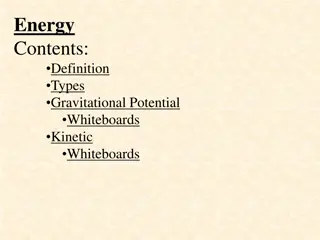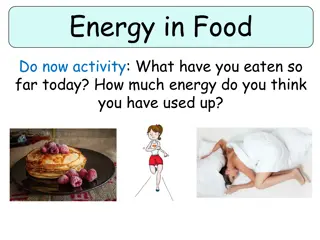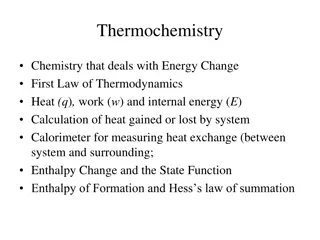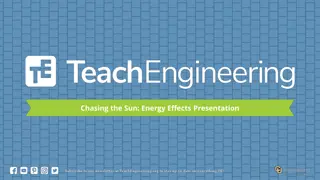Energy
Energy, an essential concept in physics, is often misunderstood. This educational slideshow delves into related terms like speed, velocity, and acceleration, shedding light on their definitions and significance in various scientific disciplines such as chemistry, biology, and Earth science.
Download Presentation

Please find below an Image/Link to download the presentation.
The content on the website is provided AS IS for your information and personal use only. It may not be sold, licensed, or shared on other websites without obtaining consent from the author.If you encounter any issues during the download, it is possible that the publisher has removed the file from their server.
You are allowed to download the files provided on this website for personal or commercial use, subject to the condition that they are used lawfully. All files are the property of their respective owners.
The content on the website is provided AS IS for your information and personal use only. It may not be sold, licensed, or shared on other websites without obtaining consent from the author.
E N D
Presentation Transcript
Energy Written by David Ilsley Image: commons.wikimedia.org
Energy is a word everyone is familiar with. Though not many people can say exactly what it is. Actually, before we can really understand it, we have to understand a few other words. So we will go through these first. All these other words are words you will be familiar with too, though, as with energy, you might not know their exact meaning. All these words are important in understanding physics and astronomy, but they will also help in the other sciences: chemistry, biology and Earth science.
Note that the ideas in this slideshow will take some time to absorb. You may not totally get the hang of them on the first go through. Don t worry about that. Even if you just get a feel for some of the words and some familiarity with them, that will be a good start. Remember: there is no test This is all bonus knowledge. Image: commons.wikimedia.org
Speed Speed is how fast something is moving. It is the number of metres moved each second. It is measured in metres per second, m/s. This car might have a speed of 30 m/s. Image: piqsels.com
Velocity Velocity is the same as speed, except that it also takes into account the direction in which the thing is moving. For instance, a plane might have a velocity of 150 m/s to the northeast. Image: nara.getarchive.net
Acceleration An acceleration is a change in velocity. It can be a change in the speed or a change in the direction or both. When you press the accelerator in a car, the car increases its speed. It accelerates forwards. When you turn the steering wheel to the right, the car changes its direction. It increases its speed to the right: it accelerates to the right. When you put your foot on the brake, the car slows down. We sometimes call this deceleration, but it is still an example of acceleration, a change in velocity. This time the acceleration is backwards. Image: pixnio.com
Acceleration In physics, acceleration actually means the rate at which velocity is changing, i.e. the change in velocity per second. So, if something changes from 10 m/s to the right to 20 m/s to the right in 2 seconds, we say its acceleration is 5m/s/s. m/s/s is usually written as m/s2. So the acceleration is 5m/s2 to the right. Image: pxhere.com
Vectors and Scalars Note that, like velocity, acceleration has a direction as well as an amount. Things like velocity and acceleration which have a direction as well as an amount are called vectors . Things like speed that don t include a direction are called scalars . It s not crucial to remember this here. Image: commons.wikimedia.org
Momentum The momentum of a body is its mass (measured in kilograms) multiplied by its velocity (measured in m/s). We usually abbreviate momentum to p, mass to m and velocity to v. So p = m v Image: commons.wikimedia.org
p = m v Momentum is a measure of how much effect something has on you if it hits you. Something with a mass of 1 kg hitting you at 1 m/s (p= 1 kg m/s) won t knock you over. Something with a mass of 50 kg hitting you at 1 m/s or something with a mass of 1 kg hitting you at 50 m/s (p = 50 kg m/s) might knock you over. Something with a mass of 50 kg hitting you at 50 m/s (p = 2500 kg m/s) will definitely knock you over. It ll probably kill you to. Image: pixabay.com
A stationary body will remain stationary unless something gives it a push (or a pull). In the same way, a moving body (like a billiard ball rolling across a table or an asteroid flying through space) will continue with the same velocity unless something gives it a push (or a pull). Image: flickr.com Such a push or a pull is called a force . A force is that which can change the velocity of something. A force is measured in Newtons. 1 Newton (1 N) will cause something with a mass of 1 kg to accelerate at 1 m/s2. The force is the mass the acceleration: F = m a Image: commons.wikimedia.org
The gravity near the Earths surface applies a force of about 10 N to each kilogram of matter. This is enough to accelerate it at 10 m/s/s. So, a falling object will increase its speed by 10 m/s each second. After 4 seconds it will be moving at 40 m/s. Image: picryl.com
However, if the object is standing on the ground, then gravity doesnt cause it to accelerate at all. Why is this? It s because the ground pushes upwards on the object with a force equal to the force of gravity, but in the opposite direction. These two forces cancel each other out, so there is no net force on the object and so no acceleration. In a tug o war, there are two roughly equal and opposite forces on the rope, giving a net result of 0 N. We say these forces are balanced . Image: commons.wikimedia.org
For a force to cause acceleration, it must act through a distance. You can push on the wall as much as you like, but it won t move. Image: commons.wikimedia.org However, if you push hard on a car that s sitting on level ground with the brakes off and out of gear, it will accelerate. The longer you push it, the faster it will get. But, for this to happen, you have to move with the car as it moves. We say that the force you apply must act through a distance. Image: flickr.com
Energy If you push a car with a force of 300 N and you keep pushing with that force as the car moves 10 m, then we say you have given the car 3000 Joules of energy. Energy given to an object is equal to the force applied multiplied by the distance it moves while the force is being applied (the distance through which the force acts). Energy = force distance. E = F s (Note we usually abbreviate distance to s, not d.) Image: commons.wikimedia.org
Once the car is moving, the car has that energy. Movement is a form of energy called kinetic energy . It can be shown that the kinetic energy of a moving body is equal to the mass of the body multiplied by its velocity squared, divided by 2. KE = m v2 KE = mv2 If you calculate the number of Joules of energy given to the car by pushing it and the number of Joules of kinetic energy, they will always be the same. That is provided that no energy is lost in the process, e.g. to friction.
So, kinetic energy is the energy of movement. It is one of the three types of energy. The second is potential energy. Potential energy is energy that isn t movement, but which has the potential to cause movement, in other words it can be converted to kinetic energy. Imagine a frog sitting on the floor. It has no kinetic energy. Image: pixabay.com
But if you lift the frog up 2 metres and drop it, it will gain kinetic energy as it falls. Where does this energy come from. It is converted from potential energy that you gave it in lifting it. To lift it, you have to apply a force (maybe 0.2 N) and that force had to act through a distance of 2 m. So you gave it 0.4 Joules of potential energy. When you drop it, that energy is converted to 0.4 Joules of kinetic energy. Image: pixabay.com
So energy can be converted from potential energy to kinetic energy. It can also be converted from kinetic energy to potential energy, e.g. when a coasting car rolls up a hill. But the total amount of energy never changes. This is the law of conservation of energy that says that the total energy of the universe never changes. The energy can be converted to different forms, but it is never destroyed. And it can t be created from nothing. Image: pixabay.com
The potential energy we have talked about is gravitational potential energy, because it results from the gravitational force of the Earth. If you lifted a frog in space, it wouldn t accelerate when you let it go. As there is no gravity there, there is no gravitational potential energy. Image: pxhere.com
But gravity is one of four fundamental forces. Another is the electromagnetic force. And there is electromagnetic potential energy. Imagine two protons, both positively charged and therefore repulsive. Pushing them close together required a force to act through a distance and therefore gives them energy electrical potential energy. If you let them go, they will accelerate away from each other, converting the potential energy into kinetic energy. Image: freesvg.org
Another fundamental force is the strong nuclear force. This is what holds quarks together in a proton or neutron and what holds protons and neutrons together in a nucleus. Separating the protons and neutrons in say a helium nucleus requires energy and so gives the particles energy. Thus the separated protons and neutrons have more nuclear potential energy than the combined ones. If we let them re-combine, that energy will be released. This is what happens in nuclear fusion in the Sun. Image: commons.wikimedia.org
The fourth fundamental force, the weak nuclear force isnt really an attraction or a repulsion, so we don t really have weak nuclear potential energy. Thus there are three types of potential energy: gravitational, electrical and nuclear. Image: pixabay.com
Potential energy can be thought of as energy due to position in a force field. A planet has a gravitational force field around it. Objects in positions further from the planet have greater potential energy than similar objects closer to it. In the same way an atomic nucleus, being positively charged, has a force field around it tending to repel protons and attract electrons. Electrons in different positions have different electrical potential energies: those closer have lower potential energies than those further away. However, with other protons those closer to the nucleus have higher potential energy than those further away. Image: pixabay.com
Electric potential energy can show itself in various ways. The electric force keeps electrons near atomic nuclei. In chemical reactions, these electrons are rearranged, changing their electrical potential energy. For instance, hydrogen can react with oxygen to form water. 2H2 + O2 2H2O Image: commons.wikimedia.org The water has less electrical potential energy than the hydrogen and oxygen, so when the hydrogen and oxygen react, they release energy. We often call this energy chemical potential energy, but it is really a form of electrical potential energy.
Energy can be stored in a spring, e.g. to fire a toy rocket. Image: flickr.com This stored energy is also electrical potential energy. It results form the fact that, when you compress the spring, it distorts the metal, causing electrons to move slightly further from the nuclei. There are other types of electrical potential energy too, e.g. the energy stored in batteries or thunder clouds.
Now when you release the spring in a toy rocket launcher, the electrical potential energy is converted to kinetic energy. But where does that energy go when the rocket hits the ground and stops? The rocket hitting the ground, it jolts the molecules in the ground and the rocket and causes them to vibrate a bit faster, increasing their kinetic energy. This kind of kinetic energy is called heat. The temperature rises a little bit. Image: euractiv.fr When hydrogen and oxygen react, a lot more energy is released, producing a lot more heat. This heat energy can be used to drive a bus.
Rest-mass Energy So, energy can be kinetic (movement of a whole body or its individual molecules) or potential (gravitational, electric or nuclear). That s two of the three types. The third type is the energy that particles like electrons and protons are made of. This is called rest-mass energy. This type of energy is not easily converted to kinetic or potential energy or vice versa. But it can be. When an electron and a positron (anti-electron) meet, they annihilate each other, i.e. they cease to be an electron and a positron, and turn into gamma ray photons. Now photons are energy kinetic energy. So rest-mass energy is converted to kinetic energy. Also, in a particle accelerator, kinetic energy of fast-moving protons is converted to the rest-mass energy of particles like mesons and Higgs bosons.
The amount of rest-mass energy in a particle is given by Einsteins equation E = mc2. As c2 is about 9 1016, the rest-mass energy of particles is very large. This is why protons had to be accelerated to 99.999 999% of the speed of light to produce a Higgs boson. Image: commons.wikimedia.org
So, energy is not matter, not a thing you can look at or hold. Its a state that matter is in. All matter has rest-mass energy. Moving matter has kinetic energy and matter in a force field (e.g. a gravitational field or electric field) has potential energy. Energy can be converted from one form to another, but it is never lost or created. The total energy of the universe remains constant. What happens when a moving object stops because of friction? Where does its kinetic energy go? It is converted to heat energy kinetic energy of individual molecules. It isn t lost. Rub your hands together and the friction will cause the skin on your palms to heat up.
When you push a car and give it kinetic energy, where does the energy come from? It comes from the chemical energy of the glucose and oxygen in your muscles as they are converted to lower-energy carbon dioxide and water. Image: flickr.com The glucose comes from the food you eat and the oxygen comes from the air you breathe. This is the source of all your energy. Energy is wonderful. Where would we be without it?
Units for Energy So, the unit of energy is the Joule. The standard abbreviation is J. The nutritional information on packets of food gives the energy per serve in kiloJoules (kJ). Calories are an old unit, but are still sometimes used for the energy content of foods. A calorie (1 cal) is the energy required to heat 1 g of water by 1 C . 1 Cal = 1 kcal 4.2 kJ. Image: world.openfoodfacts.org
Particle Energies The energies of particles like electrons are very much smaller than a Joule. The rest-mass energy of an electron is 8.2 10 14 J. So for such particles, we usually use a different unit for energy, the electron volt (eV). 1 eV = 1.6 10 19 J. The rest-mass energy of an electron is then 511 000 eV or 0.511 MeV. An electron volt is the energy given to an electron when it travels through a electrical potential difference of 1 volt. If you haven t learnt much about electricity, that probably won t make a lot of sense. Don t worry. Just remember that an electron volt is a small unit of energy. Image: commons.wikimedia.org
Power Power is the rate at which energy is supplied, i.e. the number of Joules supplied per second. 1 J/s is called 1 Watt (1 W). A typical LED light bulb might use about 10 W. An electric heater might use 1000 W (1 kW). A typical power station produces about 109 W. The Sun provides about 1 kW to each square metre on Earth exposed to it. In total, the Sun produces about 3.8 1026 W. Image: piqsels.com
Thats it. Were out of Energy. Image: pixabay.com

























